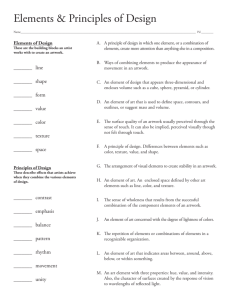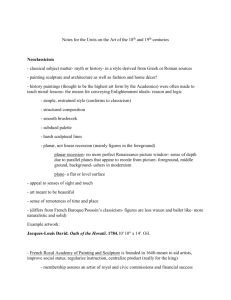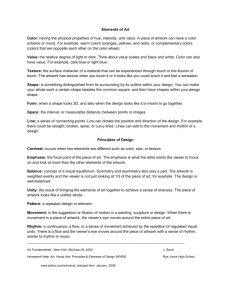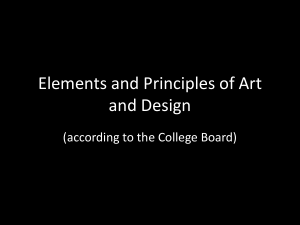Art Elements & Principles Study Guide
advertisement
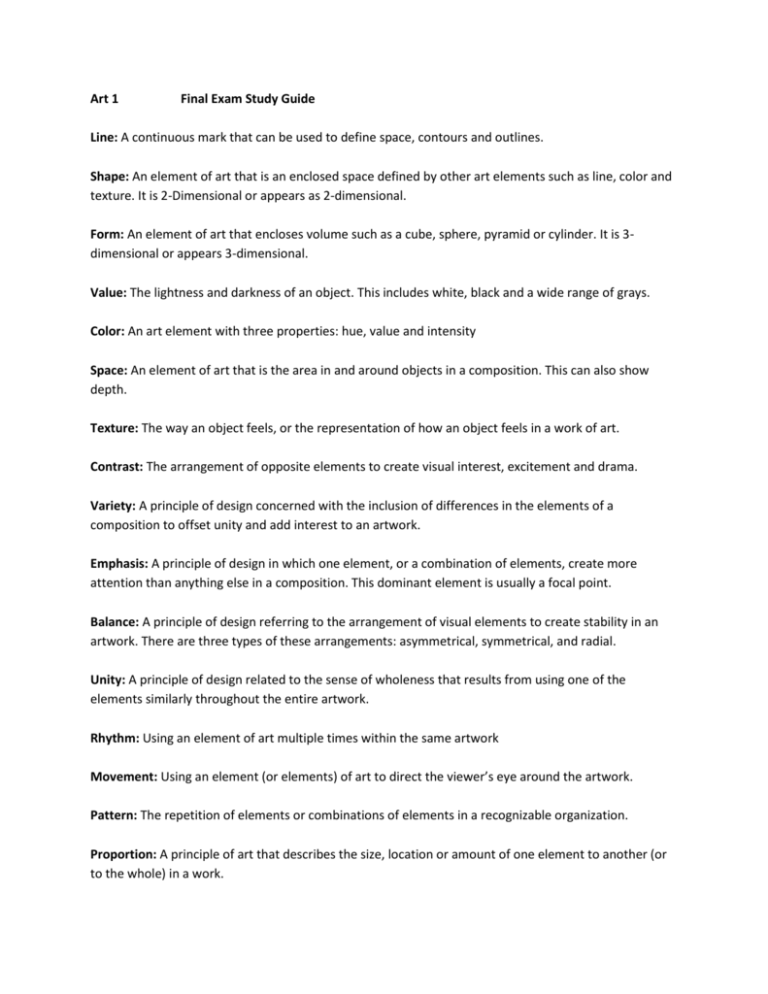
Art 1 Final Exam Study Guide Line: A continuous mark that can be used to define space, contours and outlines. Shape: An element of art that is an enclosed space defined by other art elements such as line, color and texture. It is 2-Dimensional or appears as 2-dimensional. Form: An element of art that encloses volume such as a cube, sphere, pyramid or cylinder. It is 3dimensional or appears 3-dimensional. Value: The lightness and darkness of an object. This includes white, black and a wide range of grays. Color: An art element with three properties: hue, value and intensity Space: An element of art that is the area in and around objects in a composition. This can also show depth. Texture: The way an object feels, or the representation of how an object feels in a work of art. Contrast: The arrangement of opposite elements to create visual interest, excitement and drama. Variety: A principle of design concerned with the inclusion of differences in the elements of a composition to offset unity and add interest to an artwork. Emphasis: A principle of design in which one element, or a combination of elements, create more attention than anything else in a composition. This dominant element is usually a focal point. Balance: A principle of design referring to the arrangement of visual elements to create stability in an artwork. There are three types of these arrangements: asymmetrical, symmetrical, and radial. Unity: A principle of design related to the sense of wholeness that results from using one of the elements similarly throughout the entire artwork. Rhythm: Using an element of art multiple times within the same artwork Movement: Using an element (or elements) of art to direct the viewer’s eye around the artwork. Pattern: The repetition of elements or combinations of elements in a recognizable organization. Proportion: A principle of art that describes the size, location or amount of one element to another (or to the whole) in a work. Positive Space: The space occupied by the objects in a work of art. Negative Space: The space around the objects or forms in a work of art. Thumbnail sketches: SMALL sketches made to plan a work of art. They help the artist make decisions about how to compose their artwork. Schema: An image that comes from an artist’s brain (instead of observation) Blind Contour drawing: A drawing that requires the artist to only look at the subject matter and not at their paper. Composition: The arrangement of the elements of art and principles of design within an artwork. Vanishing point: When an artist uses linear perspective, the lines of depth converge at this point. Medium: This is the material the artist uses to create their artwork. Examples of Media (medium plural) are graphite, watercolor, acrylic paint, markers, crayons, clay, etc. Kinetic Art: Artwork that actually moves- movement could be due to air currents in the room, or the artwork could contain a motor or something else that generates the movement. Four Shading Techniques Blending: Hatching: Cross-hatching: Stippling: The primary colors are red, yellow, and blue. When you mix these together, you get the secondary colors: orange, green and violet. Red + Yellow = Orange. Blue + Yellow = Green. Red + Blue = Violet. When you add white to a color, it’s called a tint. When you add black to a color, it’s called a shade. Colors BESIDE each other on the color wheel are called analogous. Colors OPPOSITE each other on the color wheel are called complementary. Know examples of each. Monochromatic means “one color.” To create a monochromatic painting, you use only one color with a variety of values (created by mixing the color with white and black). Colors that are made by mixing a primary and secondary color (next to each other on the color wheel) are called tertiary colors. Intensity is the brightness or dullness of a color. Hue is the name of the color. The Value of a color is how light or dark it is. Actual texture is the actual texture of objects (the way it actually feels). Examples: furry, smooth, bumpy, rough, bristly, etc. Simulated texture is when an artist tries to make it LOOK like a texture using some sort of artist’s medium. For example, an artist may stipple with a graphite pencil to create the simulated texture of sand. (It doesn’t actually feel like sand, it just looks like sand). Know how to draw a box in 1-point perspective: Symmetrical Balance: When an artwork is exactly the same on two sides. Example: Approximately Symmetrical Balance: When an artwork is almost the same on two sides. Example: Asymmetrical Balance: When an artwork is different on two sides, but visually balanced. Example: Radial Balance: A balance arrangement that results from the repetitive placement of elements radiating out from a central point. Example: Techniques that an artist can use to show depth: Linear Perspective: Artists use 1, 2 or 3 vanishing points with converging lines. Overlapping: When one thing is drawn in front of another thing, blocking part of your view of the object in the back. Aerial Perspective: Changing the colors in the background to lighter, grayer and sometimes bluer colors to make things look farther away. High/Low Placement: Things at the bottom of a picture tend to appear closer and objects and the top of a picture appear farther away. Be able to critique a work of art using the four steps of art criticism. Description: What is given on the label of the artwork? What is the title? Who is the artist? When and where was the work created? What tools or instruments were used to create it (media)? –examples: paint, graphite, etc. Describe the subject matter. Analysis: What steps were used to create the work? Where does your eye look first? Second? Where do you see similar or repeated shapes? How does this affect where your eye looks? Are there any lines that connect shapes together? How are the elements of art used? What colors are used? Is there texture? Is their depth? How is the positive/negative space arranged? How are the principles of art used? Is the work balanced? Is there contrast? What is the focal point? Do you see repetition of any art elements? Is there a variety of anything? Interpretation: How does the work make you think or feel? Does the work remind you of other things you have experienced? How does the work relate to other ideas or events in the world? How does the work relate to things you have studied? What is happening in the artwork? What do you think the artist is trying to say? Evaluation: Present your opinion of the work’s success or failure. What qualities of the work make you feel it is a success or failure? Compare it with similar works that you think are good or bad. What criteria can you list to help others judge this work?



